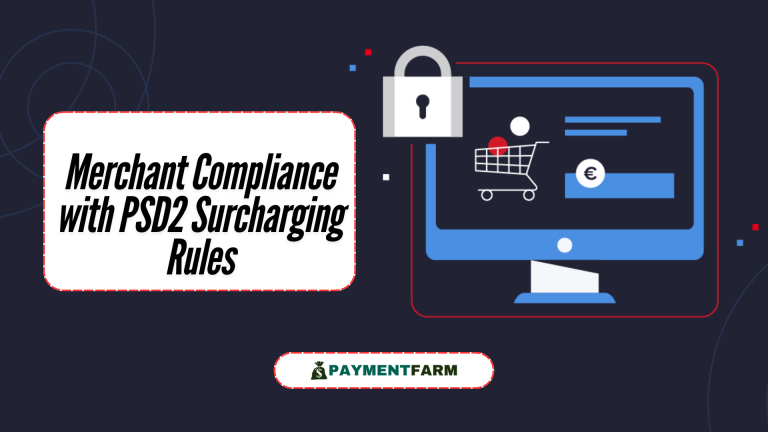The Seamless compliant surcharging Directive 2, which is a transformative framework for the European Union, has objectives to strengthen consumer protection and innovation and transparency in the payment services. The impacts of PSD2, key among them, is surcharging practice, an essential aspect for merchants in that they have to contend with the complexities of the payments processing fees and compliance issues. This article takes it upon itself to analyze Seamless compliant surcharging rules under PSD2, their implications, and strategies for merchants to stay within the lines of compliance with the least hassle.

Surcharge Prohibition Under PSD2
The PSD2 mandates a prohibition on surcharging for certain types of payment methods, specifically consumer credit and debit cards. The prohibition applies to instruments covered by EU law, including those under the IFR, which sets interchange fee caps for consumer cards.
The surcharge prohibition seeks to:
Improve consumer protection: By eliminating surprise fees during transactions.
Promote transparency: Ensure consumers are informed of the real price of goods and services.
Encourage uniformity: Provide a level playing field for merchants and consumers within EU member states.
Merchant Compliance with PSD2 Surcharging Rules

Achieving compliance requires merchants to: Not apply surcharges on regulated payment methods. These include consumer credit cards, debit cards, and some other electronic payment methods.
Understand country-specific variations: PSD2 creates overarching rules, but different EU countries may add other requirements or exemptions for specific payment methods.
Transparency in fees for payment processing: Communicate clearly the fees charged to consumers in order to avoid penalties and gain their trust.
Legal Framework and Enforcement: The European Commission’s Payment Surcharge Rules and Consumer Protection Directives give the national authorities the power to enforce compliance with surcharges. Non-compliance would result in significant penalties, reputational damage, and loss of consumer trust. Merchants must keep up to date with changing guidelines and enforcement mechanisms to avoid pitfalls.
Strategic Approaches for Seamless compliant surcharging
Even though the surcharge ban does not extend to every mode of payment businesses can implement the following controls to manage their cost of payment processing and be within compliance:

- Streamline Acceptable Modes of Payment : Seamless compliant surcharging-banned modes of payment shall be encouraged to adopt those which are not. Use incentives or discounts given on surcharge-free payment options with which customers prefer using by providing indirect discounts from surcharging.
- Clearer Fee Information: Clearly indicate any surcharge exempt fees for the available forms of payment. Under Payment Fee Disclosure Requirements; a step to increase consumers’ confidence and regulatory compliance
- Effective Solution Payment Processing: Partner with MSCs lower payment service providers and competitive interchange fee-based companies. Use the technologies for efficient low cost-payment processing.
Country-specific consideration
- PSD2 is the standard in the EU, but merchants must understand the Country-Specific Payment Fee Policies in the EU. For instance:
- Some countries have rules stricter than PSD2.
- Others allow limited surcharging in certain payment methods, for example, commercial cards.
- Knowledge of these details provides full compliance across jurisdictions.
Key Takeaways for Merchants
- The Credit Card Seamless compliant surcharging Ban in Europe under PSD2 compels merchants to have transparent and surcharge-free practices in regulated payment methods.
- Compliance is not only a legal obligation but also a business imperative to build consumer trust and foster loyalty.
- Such strategic adaptation can include the provision of alternative payment options and optimizing fees in such a way that it ensures cost-effectiveness under PSD2.
Conclusion
Seamless compliant surcharging restrictions under PSD2 are expected to bring a sharp awareness of the legal system and an affirmative response toward the need. Merchants will have themselves ensuring fluid compliance through focus on transparency, modern payment innovations, and constant awareness of domestic regulations to uphold efficiency in the operations. This is precisely how it would enable these practices to give businesses the sustainable edge for their operations across Europe.
FAQs
What is a surcharge ban under PSD2?
PSD2 prohibits merchants from levying a Seamless compliant surcharging on all regulated forms of payments, including consumer credit cards and debit cards, thereby improving transparency and consumer protection.
Does the prohibition on Seamless compliant surcharging apply also to all types of payments?
No, but the surcharge prohibition is related specifically to consumer credit and debit cards that come under EU regulation. Commercial cards or a direct bank transfer are among the payment methods that exempt from the prohibition.
How do merchants respond to PSD2 surcharges?
The merchants can conform by refraining from using surcharges on regulated payment service, making an understanding in the differences of countries or regions and disclosing fee transparently, among other measures.
Are fines applicable if merchants fail to comply with PSD2?
Yes, in fact, the failure to comply can cause extreme penalties and reputational problems as consumers lose faith in national authorities.
Are discounts allowed on a particular payment options?
This would mean that, if the procedures comply with the requirements of PSD2, retailers can offer their customers rebates or other types of benefits for using preferred means of payment.
Do country-specific rules affect the surcharging practices?
While PSD2 offers EU-wide standards, other countries may have more specific rules or exemptions that a merchant needs to follow.
What are the advantages of adopting Seamless compliant surcharging methods?
Seamless compliant surcharging-free payment methods enhance consumer trust and customer experience while also keeping PSD2 regulation compliance smooth.
